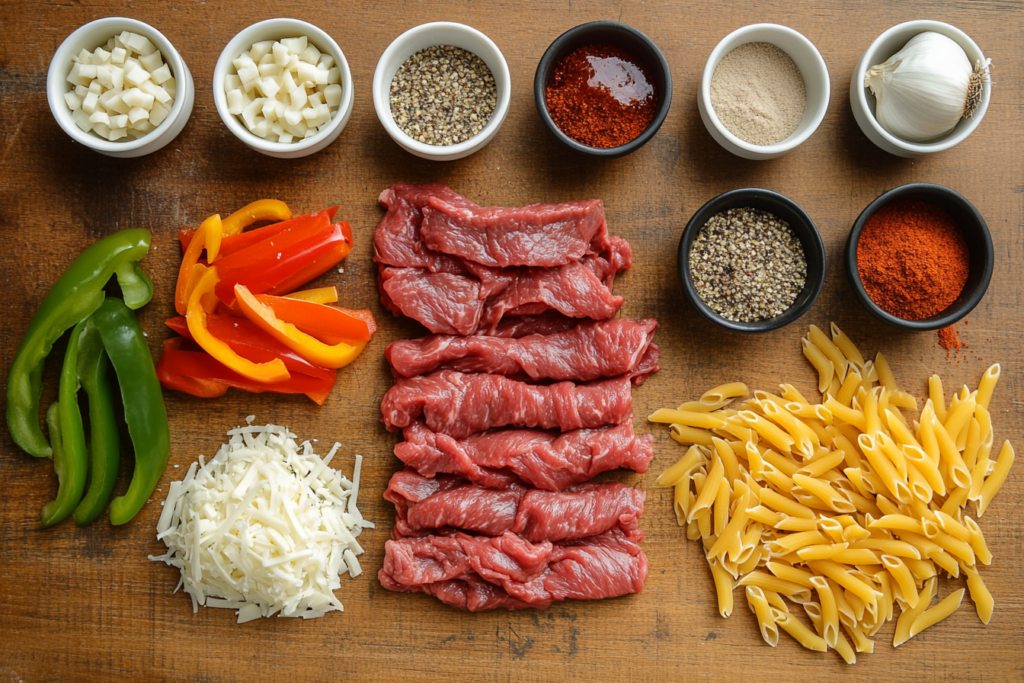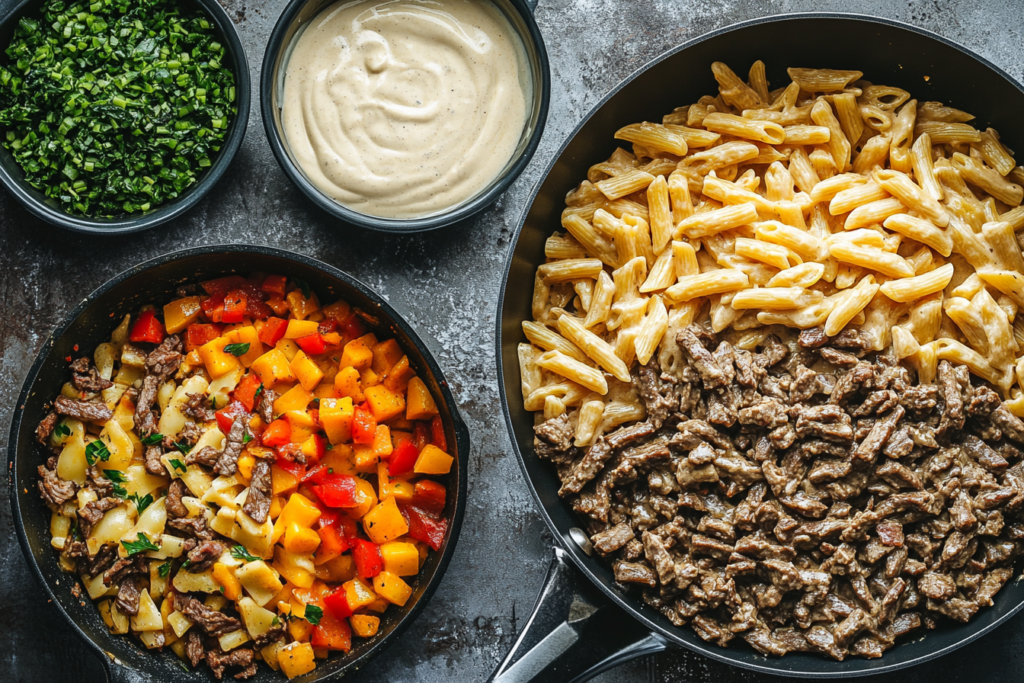Table of contents
Introduction to Philly Cheesesteak Pasta
What is Philly Cheesesteak Pasta?
Philly Cheesesteak Pasta is a delightful fusion of two culinary classics: the iconic Philly cheesesteak and comforting pasta dishes. It combines the rich, savory flavors of thinly sliced beef, sautéed onions, and bell peppers with a creamy, cheesy sauce, all tossed with perfectly cooked pasta. This dish takes the essence of a traditional Philly cheesesteak sandwich and transforms it into a hearty, family-friendly meal that’s as satisfying as it is unique.
The magic of Philly Cheesesteak Pasta lies in its ability to marry the distinct tastes of its source inspiration. From the tender beef and melted cheese to the soft pasta, every bite offers a perfect blend of textures and flavors. It’s a crowd-pleaser, ideal for weeknight dinners or special gatherings, providing a comforting yet exciting twist on a familiar favorite.
The Origin of Philly Cheesesteak and Its Culinary Adaptation in Pasta Form
The Philly cheesesteak originated in Philadelphia in the 1930s, credited to brothers Pat and Harry Olivieri. Initially, they created this iconic sandwich by grilling beef and serving it in a long hoagie roll. Later, they added melted cheese for extra richness, which elevated its appeal. Over the years, the Philly cheesesteak became a symbol of the city’s food culture, loved for its simplicity and bold flavors.
As culinary creativity grew, chefs and home cooks began reimagining classic dishes. This eventually led to the birth of Philly Cheesesteak Pasta. This adaptation retains the foundational ingredients—beef, cheese, and onions—while also incorporating pasta as a base to make it a heartier, more versatile dish. Moreover, the pasta version broadens the appeal of the original by making it accessible to a wider audience, including those who may prefer a pasta-centric comfort food over a sandwich.
Philly Cheesesteak Pasta is not just a testament to the popularity of its namesake but also a shining example of how classic recipes can inspire innovation in the culinary world. Furthermore, this dish captures the essence of tradition while simultaneously embracing modern tastes, ensuring its place as a beloved recipe in kitchens everywhere.
Ingredients of Philly Cheesesteak Pasta

Key Components of the Dish
Philly Cheesesteak Pasta revolves around a few essential ingredients that bring the dish to life. These key components include:
- Beef: Traditionally, thinly sliced ribeye or ground beef is used for its rich, juicy flavor and tender texture.
- Cheese: Provolone, American cheese, or even a blend of cheddar and mozzarella provide the creamy, melty essence synonymous with a Philly cheesesteak.
- Pasta: Penne, rigatoni, or fusilli are popular choices, as they hold the sauce well, creating a satisfying bite.
- Vegetables: Sautéed onions, green bell peppers, and sometimes mushrooms add a savory depth to the dish.
- Cream Sauce: A base of heavy cream, cream cheese, or a béchamel-like sauce enriches the dish and ties the flavors together.
- Seasonings: Garlic, salt, pepper, and Worcestershire sauce enhance the overall taste, adding complexity to the dish.
Substitutions for Dietary Restrictions
To accommodate various dietary needs, substitutions can be made without compromising the dish’s flavor:
- For Vegetarians: Replace the beef with plant-based meat alternatives or hearty vegetables like portobello mushrooms or eggplant.
- For Gluten-Free Diets: Use gluten-free pasta made from rice, lentils, or chickpeas to ensure the dish is suitable for those with gluten sensitivities.
- For Dairy-Free Options: Substitute regular cheese with dairy-free alternatives made from almond, coconut, or cashew bases, and use plant-based milk or cream in the sauce.
- For Low-Carb or Keto-Friendly Diets: Replace traditional pasta with zucchini noodles (zoodles) or shirataki noodles while maintaining the other components.
Fresh vs. Processed Ingredients
When making Philly Cheesesteak Pasta, the choice between fresh and processed ingredients can significantly impact the flavor and quality of the dish.
- Fresh Ingredients: Using fresh beef, cheese, and vegetables enhances the dish’s natural flavors and ensures a healthier meal. Freshly grated cheese, for example, melts more smoothly and avoids the additives found in pre-shredded varieties.
- Processed Ingredients: While convenient, processed ingredients like canned vegetables or pre-cooked meats may lack the depth of flavor and nutritional value of fresh options. However, they can be useful for quick and easy preparation when time is limited.
Striking a balance between fresh and processed ingredients can cater to both convenience and taste. Whenever possible, opting for fresh elements will elevate the dish, making it more flavorful and satisfying.
Step-by-Step Recipe for Philly Cheesesteak Pasta
Preparation of the Meat
- Select the Meat: Choose thinly sliced ribeye steak, ground beef, or your preferred meat alternative for the dish.
- Season the Meat: Lightly season the beef with salt, pepper, and a touch of garlic powder to enhance its natural flavors.
- Cook the Meat:
- Heat a large skillet over medium-high heat.
- Add a small amount of oil or butter.
- Sear the meat slices or cook ground beef until browned and fully cooked. Ensure the meat is tender and juicy, not overcooked.
- Remove and Rest: Transfer the cooked meat to a plate and set it aside while preparing the other components.

Cooking the Pasta
- Choose the Pasta: Opt for short pasta shapes like penne, rigatoni, or fusilli, which work well with the sauce and toppings.
- Boil Water: Bring a large pot of salted water to a boil.
- Cook the Pasta: Add the pasta to the boiling water and cook according to the package instructions until al dente. This ensures the pasta is firm enough to hold its shape when combined with the sauce.
- Drain and Reserve: Drain the pasta, reserving a cup of pasta water for adjusting the sauce consistency later.
Combining the Sauce and Other Ingredients
- Sauté the Vegetables:
- In the same skillet used for the meat, add a bit more oil or butter.
- Sauté sliced onions, green bell peppers, and mushrooms (if using) until softened and slightly caramelized.
- Add minced garlic and cook for an additional minute.
- Prepare the Sauce:
- Lower the heat to medium.
- Add heavy cream or a combination of cream cheese and milk to the skillet.
- Stir in shredded cheese (Provolone, mozzarella, or your choice) until melted and smooth.
- Season with Worcestershire sauce, salt, and pepper to taste.
- If the sauce is too thick, use the reserved pasta water to achieve the desired consistency.
- Combine the Ingredients:
- Add the cooked pasta and meat to the skillet with the sauce.
- Toss everything together until evenly coated.
- Allow the dish to simmer for a couple of minutes so the flavors meld.
- Garnish and Serve:
- Top with additional cheese or fresh parsley for garnish, if desired.
- Serve hot, straight from the skillet, for the best flavor and texture.
By following these steps, you’ll create a rich and satisfying Philly Cheesesteak Pasta that balances the bold flavors of the original sandwich with the comforting appeal of pasta.
Variations of Philly Cheesesteak Pasta
Vegetarian Version
For a meat-free take on Philly Cheesesteak Pasta, you can make simple yet flavorful substitutions:
- Meat Alternative: Replace the beef with hearty vegetables like portobello mushrooms, eggplant slices, or zucchini. These provide a meaty texture and rich flavor.
- Cheese Options: Stick with traditional cheeses like Provolone or mozzarella, or opt for dairy-free cheese if needed.
- Flavor Boost: Incorporate soy sauce, liquid smoke, or a splash of Worcestershire sauce (vegetarian version) to mimic the savory umami of beef.
- Protein Add-Ons: Add plant-based proteins like tofu crumbles, tempeh, or seitan for a protein-packed dish.
- Cooking Method: Follow the same steps for sautéing and combining ingredients, ensuring the vegetables are tender and well-seasoned.
Gluten-Free Option
For those with gluten sensitivities or preferences, this variation ensures the dish is safe and delicious:
- Pasta Substitute: Use gluten-free pasta made from rice, quinoa, lentils, or chickpeas. These hold sauce well and maintain a similar texture to regular pasta.
- Gluten-Free Sauce: Ensure all sauces and seasonings, such as Worcestershire sauce, are certified gluten-free.
- Cross-Contamination: If preparing for someone with a gluten allergy, clean all cooking tools and surfaces thoroughly before starting.
- Preparation: Cook and combine the gluten-free pasta with the other ingredients as you would in the original recipe, ensuring all components are compatible.
Spicy Philly Cheesesteak Pasta
For those who enjoy a kick of heat, this variation adds bold, spicy flavors to the dish:
- Spicy Meat: Season the beef with cayenne pepper, smoked paprika, or chili powder during cooking. Alternatively, use spicy Italian sausage for an extra punch.
- Pepper Addition: Include spicy peppers like jalapeños or red chili flakes when sautéing the onions and bell peppers.
- Cheese Twist: Use Pepper Jack cheese or add a few dashes of hot sauce to the creamy sauce for an added layer of heat.
- Final Touch: Garnish with chopped fresh chili or a sprinkle of crushed red pepper flakes for a vibrant finish.
- Adjust Spice Levels: Tailor the spice to your preference, adding more or less heat as desired to suit your taste.
These variations allow you to customize Philly Cheesesteak Pasta to suit different dietary needs and flavor preferences while maintaining the essence of this comforting, versatile dish.
Related Recipes You’ll Love
For fans of classic Philly flavors, this Philly Cheesesteak Pasta recipe pairs perfectly with other creative takes on the original, such as Philly Cheesesteak Egg Rolls, offering a crispy and savory twist to the beloved dish. Additionally, if you’re exploring indulgent, comfort-style recipes, you might enjoy experimenting with desserts like the Brookie Recipe, which combines brownies and cookies for the ultimate sweet treat. Both recipes are perfect for rounding out a meal inspired by bold, hearty flavors.
Frequently Asked Questions about Philly Cheesesteak Pasta
How Can I Make It in Advance?
Yes, Philly Cheesesteak Pasta can be prepared in advance for convenience. Here’s how:
- Cook the Components Separately: Prepare the pasta, meat, and sauce individually but do not combine them yet.
- Store Properly: Store each component in separate airtight containers in the refrigerator for up to 2 days.
- Reheat and Combine: When ready to serve, reheat the meat and sauce on the stove, adding a splash of milk or reserved pasta water to loosen the sauce. Warm the pasta separately, then toss everything together before serving.
- Final Touch: Add freshly shredded cheese right before serving to restore the creamy, gooey texture.
Can I Freeze Philly Cheesesteak Pasta?
Yes, Philly Cheesesteak Pasta can be frozen for longer storage, but there are some tips to ensure quality:
- Prepare the Dish: Cook the pasta and combine it with the meat and sauce as usual, but avoid adding fresh vegetables or garnishes.
- Cool Completely: Allow the dish to cool completely before transferring it to a freezer-safe container or resealable freezer bag.
- Label and Store: Label the container with the date and freeze for up to 2 months.
- Reheating Tips: When reheating, thaw overnight in the refrigerator, then warm gently on the stove or in the oven, adding a bit of cream or milk to refresh the sauce’s texture.
What Cheese Works Best?
The best cheese for Philly Cheesesteak Pasta depends on personal taste, but here are a few popular options:
- Provolone: The classic choice, it melts smoothly and has a mild, creamy flavor that pairs well with the savory beef and vegetables.
- Mozzarella: Perfect for a gooey texture, mozzarella adds a touch of richness without overpowering the other flavors.
- Cheddar: For a sharper, more robust flavor, cheddar is an excellent addition, particularly in combination with cream cheese or heavy cream.
- American Cheese: A classic for Philly cheesesteaks, it melts effortlessly into the sauce, creating a velvety consistency.
Experiment with a blend of these cheeses to achieve your preferred balance of flavor and texture.
Conclusion: Why You Should Try Philly Cheesesteak Pasta Today
Summary of Its Versatility and Appeal
Philly Cheesesteak Pasta is a perfect combination of rich, hearty flavors and comforting textures, making it a versatile dish suitable for any occasion. Whether you’re preparing a casual family dinner or looking for something unique to impress guests, this dish delivers taste and satisfaction. Its adaptability to different dietary preferences and easy customizations—such as vegetarian or spicy versions—makes it a favorite among diverse palates. From the savory beef to the creamy, cheesy sauce and perfectly cooked pasta, every bite offers a delightful medley of flavors that pays homage to the classic Philly cheesesteak.
Encouragement to Experiment with the Recipe
One of the best aspects of Philly Cheesesteak Pasta is how customizable it is. Don’t hesitate to experiment with ingredients to make it your own! Try using your favorite cheese combinations, adding extra veggies, or incorporating spicy elements for a bold twist. Swap traditional pasta with gluten-free or low-carb alternatives to suit your lifestyle without sacrificing taste. This recipe is a canvas for creativity, and each variation ensures a new and exciting experience. So, gather your ingredients, get cooking, and enjoy this irresistible fusion of classic and modern comfort food!

